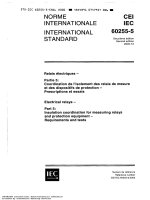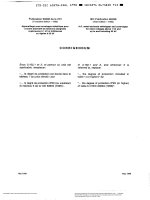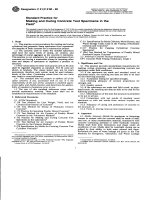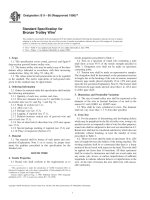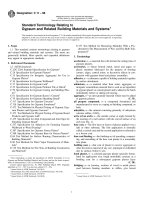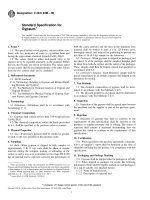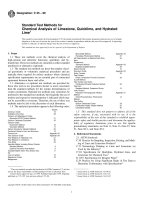Designation: C 5 – 79 (Reapproved 1997) - Quicklime for Structural Purposes1 pot
Bạn đang xem bản rút gọn của tài liệu. Xem và tải ngay bản đầy đủ của tài liệu tại đây (21.49 KB, 2 trang )
Designation:C5–79(Reapproved 1997)
Standard Specification for
Quicklime for Structural Purposes
1
This standard is issued under the fixed designation C 5; the number immediately following the designation indicates the year of original
adoption or, in the case of revision, the year of last revision. A number in parentheses indicates the year of last reapproval. A superscript
epsilon (e) indicates an editorial change since the last revision or reapproval.
This standard has been approved for use by agencies of the Department of Defense.
1. Scope
1.1 This specification covers all classes of quicklime such as
crushed lime, granular lime, ground lime, lump lime, pebble
lime, and pulverized lime, used for structural purposes.
2. Referenced Documents
2.1 ASTM Standards:
C 25 Test Methods for Chemical Analysis of Limestone,
Quicklime, and Hydrated Lime
2
C 50 Practice for Sampling, Inspection, Packing, and Mark-
ing of Lime and Limestone Products
2
C 51 Terminology Relating to Lime and Limestone (As
Used by the Industry)
2
C 110 Test Methods for Physical Testing of Quicklime,
Hydrated Lime, and Limestone
2
E 11 Specification for Wire-Cloth Sieves for Testing Pur-
poses
3
3. Terminology
3.1 Definitions—Unless otherwise specified, for definitions
of terms used in this standard, refer to Terminology C 51.
4. Chemical Composition
4.1 The quicklime shall conform to the following require-
ments as to chemical composition, calculated on a nonvolatile
basis:
Calcium Lime Magnesium Lime
Calcium oxide, min, % 75
Magnesium oxide, min, % 20
Calcium and magnesium oxide,
min, %
95 95
Silica, alumina, and oxide of iron,
max, %
55
Carbon dioxide, max, %:
If sample is taken at place of
manufacture
33
If sample is taken at any other
place
10 10
5. Residue
5.1 The quicklime shall contain no more than 15 weight %
of residue.
6. General Requirements
6.1 Quicklime shall be slaked and aged in accordance with
the printed directions of the manufacturer. The resulting lime
putty shall be stored until cool.
6.2 Lime putty prepared in accordance with X1.4.2 and
adjusted to standard consistency in accordance with Test
Methods C 110, shall show no pops or pits when tested in
accordance with Test Methods C 110.
6.3 Lime putty prepared as above shall have a plasticity
figure of not less than 200.
7. Sampling, Inspection, etc.
7.1 The sampling, inspection, rejection, retesting, packing,
and marking shall be conducted in accordance with Methods
C 50.
8. Test Methods
8.1 Conformance to chemical requirements shall be deter-
mined in accordance with Test Methods C 25.
8.2 Conformance to plasticity and residue requirements
shall be determined in accordance with Test Methods C 110.
9. Keywords
9.1 building (structural); calcium oxide; dolomitic lime;
high calcium lime; lime putty; magnesium oxide; plasticity;
quicklime; residue; slaking
1
This specification is under the jurisdiction of ASTM Committee C-7 on Lime
and is the direct responsibility of Subcommittee C07.02 on Structural Lime.
Current edition approved Nov. 30, 1979. Published January 1980. Originally
published as C5–13T.Last previous edition C5–59(1974).
2
Annual Book of ASTM Standards, Vol 04.01.
3
Annual Book of ASTM Standards, Vol 14.02.
1
Copyright © ASTM, 100 Barr Harbor Drive, West Conshohocken, PA 19428-2959, United States.
APPENDIX
(Nonmandatory Information)
X1. SLAKING AND PREPARATION OF LIME PUTTY
X1.1 Introduction
X1.1.1 Quicklime can never be used as such for structural
purposes; it must always be slaked first. Since the method of
slaking is an important factor in determining the quality of the
finished product, the following directions for the preparation of
lime putty are given, not as a part of the specification, but as
information for the further protection of the purchaser.
X1.1.2 Different kinds of lime vary considerably in the way
in which they behave with water. A little supervision over the
operation of slaking will amply pay for itself by ensuring the
production of the greatest possible quantity and the best
possible quality of putty. To find out how to slake a new lot of
lime, it is safest to try a little of it and see how it works. Since
different lots of the same brand of lime vary somewhat, and
since the weather conditions at the time have a decided
influence, it is wise to try a sample from each lot used, whether
familiar with the brand or not.
X1.2 Classification of Limes
X1.2.1 In a bucket, put two or three lumps of lime about the
size of one’s fist, or, in the case of granular lime, an equivalent
amount. Add sufficient water to just barely cover the lime, and
note how long it takes for slaking to begin. Slaking has begun
when pieces split off from the lumps or when the lumps
crumble. Water of the same temperature should be used for test
and field practice.
X1.2.2 If slaking begins in less than 5 min, the lime is quick
slaking; from 5 to 30 min, medium slaking; over 30 min, slow
slaking.
X1.3 Directions for Slaking
X1.3.1 Slake quicklime in accordance with the printed
directions of the manufacturer. When such directions are not
provided, proceed as follows:
X1.3.2 For quick-slaking lime, always add the lime to the
water, not the water to the lime. Have sufficient water at first to
cover all the lime completely. Have a plentiful supply of water
available for immediate use—a hose throwing a good stream,
if possible. Watch the lime constantly. At the slightest appear-
ance of escaping steam, hoe thoroughly and quickly, and add
enough water to stop the steaming. Do not be afraid of using
too much water with this kind of lime.
X1.3.3 For medium–slaking lime, add the water to the lime.
Add enough water so that the lime is about half submerged.
Hoe occasionally if steam starts to escape. Add a little water
now and then if necessary to prevent the putty from becoming
dry and crumbly. Be careful not to add any more water than
required, and not too much at a time.
X1.3.4 For slow–slaking lime, add enough water to the lime
to moisten it thoroughly. Let it stand until the reaction has
started. Cautiously add more water, a little at a time, taking
care that the mass is not cooled by the fresh water. Do not hoe
until the slaking is practically complete. If the weather is very
cold, it is preferable to use hot water, but if this is not available,
the mortar box may be covered in some way to retain the heat.
X1.4 Preparation of Putty for Use
X1.4.1 After slaking, prepare putty for use as follows:
X1.4.2 White Coat—After slaking and aging finishing
quicklime in accordance with the printed directions of the
manufacturer, store the putty until cool. If no printed directions
are provided by the manufacturer, prepare the putty for use as
follows: After the action has ceased, run off the putty through
a No. 10 (2.00-mm) sieve conforming to Specification E 11,
and store for a minimum of 2 weeks.
X1.4.3 Base Coats—After the action has ceased, run off the
putty through a No. 8 (2.36-mm) sieve conforming to Speci-
fication E 11. Add sand up to equal parts by weight, all of the
hair or other fibers required, and store for a minimum of 2
weeks.
X1.4.4 Masons’ Mortar—After the action has ceased, add
part or all of the sand required, and store for a minimum of 24
h.
The American Society for Testing and Materials takes no position respecting the validity of any patent rights asserted in connection
with any item mentioned in this standard. Users of this standard are expressly advised that determination of the validity of any such
patent rights, and the risk of infringement of such rights, are entirely their own responsibility.
This standard is subject to revision at any time by the responsible technical committee and must be reviewed every five years and
if not revised, either reapproved or withdrawn. Your comments are invited either for revision of this standard or for additional standards
and should be addressed to ASTM Headquarters. Your comments will receive careful consideration at a meeting of the responsible
technical committee, which you may attend. If you feel that your comments have not received a fair hearing you should make your
views known to the ASTM Committee on Standards, 100 Barr Harbor Drive, West Conshohocken, PA 19428.
This standard is copyrighted by ASTM, 100 Barr Harbor Drive, West Conshohocken, PA 19428-2959, United States. Individual
reprints (single or multiple copies) of this standard may be obtained by contacting ASTM at the above address or at 610-832-9585
(phone), 610-832-9555 (fax), or (e-mail); or through the ASTM website ().
C5
2
